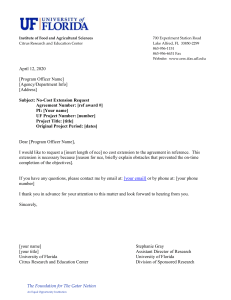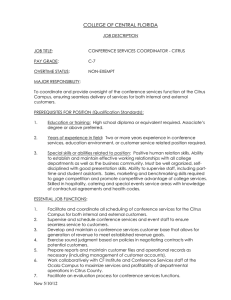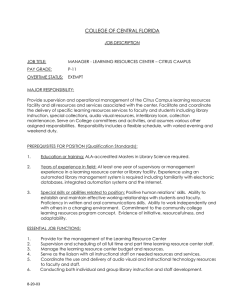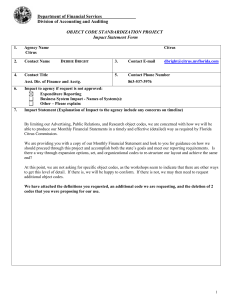eliminate the possibility of infecting the seedbeds with Phytophthora.
advertisement
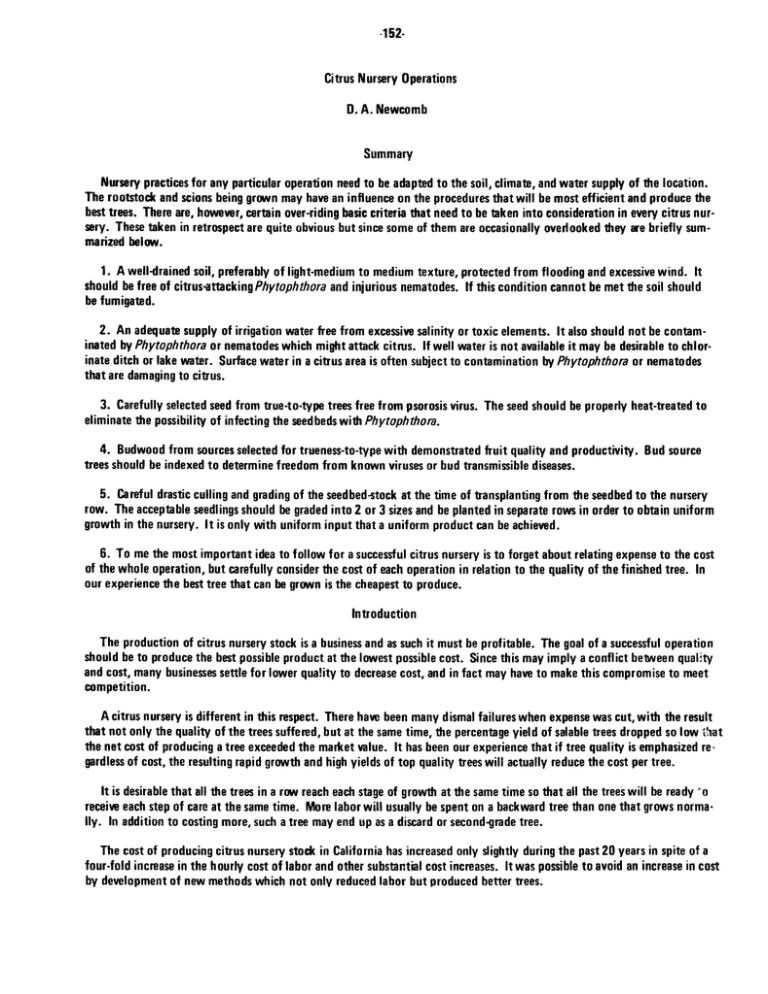
.152- CitrusNurseryOperations D. A. Newcomb Summary Nurserypracticesfor any particular operationneedto be adaptedto the soil, climate,andwater supply of the location. The rootstock and scionsbeinggrIMn may havean influenceon the proceduresthat will be most efficient and producethe besttrees. Thereare,however,certain over-ridingbasiccriteria that needto be taken into considerationin everycitrus nur~ry. Thesetaken in retrospectare quite obviousbut sincesomeof them are occasionallyoverlookedthey arebriefly summarizedbelow. 1. A well-drainedsoil, preferablyof light-mediumto mediumtexture, protectedfrom flooding and excessive wind. It should befree of citrus~ttackingPhytophthora and injurious nematodes.If this condition cannot be met the soil should be fumigated. 2. An adequatesupply of irrigation water free from excessive salinity or toxic elements. It alsoshould not be contaminated by Phytophthoraor nematodeswhich might attack citrus. If well water is not availableit may be desirableto chlorinate ditch or lake water. Surfacewater in a citrus areais often subjectto contaminationby Phytophthora or nematodes that are damagingto citrus. 3. Carefullyselectedseedfrom true-to-typetreesfree from psorosisvirus. The seedshould be properly heat-treatedto eliminatethepossibilityof infectingtheseedbeds with Phytophthora. 4. Budwoodfrom sourcesselectedfor trueness-to-type with demonstratedfruit quality and productivity. Bud source treesshould be indexedto determinefreedomfrom known virusesor bud transmissiblediseases. 5. Carefuldrasticculling and gradingof the seedbed-stock at the time of transplantingfrom tI1eseedbedto the nursery row. The acceptableseedlingsshould be gradedinto 2 or 3 sizesand be plantedin separaterows in order to obtain uniform growth in the nursery. It is only with uniform input that a uniform product can be achieved. 6. To me the most important ideato follow for a successfulcitrus nurseryis to forget about relatingexpenseto the cost of the whole operation,but carefully considerthe cost of eachoperationin relation to the quality of the finished tree. In our experiencethe besttree that can be grfNIn is the cheapestto produce. Introduction The production of citrus nurserystock is a businessand assuchit must be profitable. The goalof a successfuloperation should be to producethe bestpossibleproduct at the lowest possiblecost. Sincethis may imply a conflict betweenquality and cost, many businesses settlefor lower quality to decrease cost, and in fact may haveto makethis compromiseto meet competition. A citrus nursery is different in d1is respect. There haw been many dismal failures when expensewas cut, wid1 the result that not only the quality of the trees suffered, but at the same time, the percentage yield of salable trees dropped so low l~at tile net cost of producing a tree exceeded the mamet value. It has been our experience that if tree quality is emphasized re. gardlessof cost, the resulting rapid growth and high yields of top quality trees will actually reduce the cost per tree. It is desirablethat all the treesin a rIM reacheachstageof growth at the sametime so that all the treeswill be ready'0 receiveeachstep of careat the sametime. Morelabor will usuallybe spent on a backwardtree than onethat growsnormally. In addition to costingmore,sucha tree may end up asa discardor second-grade tree. The cost of producingcitrus nurserystod<in Californiahasincreasedonly slightly duringthe past20 yearsin spite of a four.fold increasein the hourly cost of labor and other substantialcost increases.It was possibleto avoid an increasein cost by developmentof new methodswhich not only reducedlabor but producedbetter trees. NurseryOperations The proceduresfor producinga citrus nurserytree discussedhereare relatedto 2 main objectives.The first is improvement of nurserysanitationwhich is relatedto plant quality and eventualsuccessof the orchard. The s~ond coverssomemethodsof improvingboth the plant growth andthe efficiency of the nurseryoperation. Both factors arerelatedto achievinga high yield of healthy, vigorous,uniform plants that requirea minimum of attention in the nursery. Phytophthora speciesthat attack citrus roots are a world-wide problem and every possible precaution should be taken to keep them out of the nursery. Most citrus orchards sooner or later become infected, but orchards planted with trees free of Phytophthoro make better growth and have higher production for many years when compared with orchards planted with Phytophthorainfected trees (19). It is difficult to collect citrus seedfruit and to extract seedin volumewithout introducingPhytophthora- For this reason,all seedproducedby Willits & Newcombis treated by immersionin a hot water bath at 12~F for 10 minutes(10). Heat-treated seedwill producehealthy plantsfree from Phytophthoraand other damping-offfungi when plantedin cleansoil (9). Efforts to producePhytophthora.freeseedwould be wastedunlessthe soil in the seedbedsis ~so free from Phytophthora and can be kept so. In the past,virgin land free from Phytophthoraand citrus nematodeshasgenerallybeenava~ablefor nurseries, but now it is often necessary to useland that hasbeenexposedto contaminationfrom previouscitrus plantingsor from nearby citrus. Californiaregulationsfor gr(M/ingcertified citrus nurserystock call for soi fumigation with a minimum of 300 poundsof methyl bromideper acre,immediatelycoveredwith 1 mil thick polyethylenetarp (24). The methyl bromidemay be supplemented with 150 poundsof chlorop£rin to improvethe kill of Phytophthora. This treatment is effectivefor eliminating nematodes, Phytophthora and weedseed. into the nurseryafterfumigation.The Willits & Newcombusesrigid precautionsto preventreintrodluction of Phytophthora 0 work is in progress. Workmen enteringthe nurserychangeinto nurseryis completelyfencedand the gate is kept lockedwhen n t their shoes with Bordeaux powder at frequent intervals. Tools cleanshoeswhich are kept in lockersat the entrance. They trea the hazard of contamination. When reservoirsare usedfor irriaresterilizedand many other proceduresare followed to reduce 1). Birds are always possible carriers of Phytophthora but unforDationwater they aretreatedeachmonth with coppersulfate (1 tunately the cost of screeningfor birds is prohibitive. Productionof uniform seedbed-stock startswith the correct spacingof the seed in the beds. If the seedlingsarecrowded,the first to germinatewill shadethe later ones,causingthem to be retarded. Willits & Newcombhavehad bestresultswith about 24 seedper squarefoot for the larger-leafedtypes of rootstockssuchassour orangeand roughlemon. The smaller-leafedtypes such as 'Carrizo' and 'Troyer' citrangeand 'Cleopatra'mandarindo w~1with 36 seedper squarefoot. The seedshould be spaced evenly. Oftenthe solution of one problemleadsto other problems. Seedbedsplanted in fumigatedsoil often fail to grow normally. The seedsgerminateand grow uniformly for a time but soonsomeareasbecomeretardedor completelystop growing. In other parts of the bedsthe growth is normal. For manyyearsthis wasan unsolvedproblem, but we now know that the seedlings which grow well haveendogonemycorrhizaon the roots, while the plantsthat grow poorty do not, asshown by recentwork by Kleinschmidtand Gerdemannat the Universityof Illinois (8). Apparently the fumigation dosagespecifiedfor control of nematodesand Phytophthora is not high enoughto completelykill the mycorrhizaleavingspotswhereit survives.Dr. Martin at the Universityof Californiaat Riversidehad previouslyshownthat the seedlingswith retardedgrowth werefailing to pick up phosphorousfrom the soil, and that growth could be improvedby makingheavyapplicationsof phosphatefertilizers to the so~ prior to planting (12, 13, 14, 15). This waseffectivewith certainvarieties,includingroughlemon, C.macrophylla,trifoliate andtrifoliate hybrids. Other varieties,suchas 'Cleopatra'mandarin,sour orangeand sweetorange,madeonly a partial response. The growth of thesevarietieson fumigatedsoil wasstill depressed 25%to 50%of normal in affectedareasascomparedwith spotswheregrowth was normal. The plants that were depressed startedto grow normally after the soil aroundthem wasinoculatedwith mycorrhiza. In onetrial, culturesof mycorrhizaof the endogonespeciessuppliedby Or. Gerdemannof the University of Illinois were used. In other trials soi containingcitrus roots from the spotsin the nurserywherethe plantsweregrowing normally and wherethe examinationhad shown the presenceof mycorrhizaon the roots wasmixed into the top 2 inchesof soil nearthe affectedplants. Studiesare now underway to learnthe best methodof inoculatingseedbeds with mycorrhizain order to avoidthe problem of depressed growth following fumigation. Both treatmentsweresuccessful.It is interestingthat .154- in sterileplant mixeswhich contain a low percentageof clay, plantsmay growwell without mycorrhizawhen irrigatedwith nutrient solution. Severaltechniqueshavebeendevelopedto improvethe growth of the plants. Onemethodhasbeento extend the season for the growth of the seedlingsin the seedbeds.UnderCaliforniaconditionsseedplanted in unheatedbedsdoesnot begin to germinateuntil the soil warmsup in April. The growth periodendsabout the first of Novemberwhen the soil becomes cool. This leavesabout 7 months of growingweather. This period can be extendedat least 1 month by planting the seedin late Januaryand coveringthe bedswith polyethylene. The daytimesoil temperaturecan be raisedfrom a normal of around So-Fthe first of Februaryto from 60 - 65~. On the first of Marchthe daytimetemperatureof exposedsoil will be from 60 . 6~F. Underthe polyethyleneit will be from 70 - 7S-F. In April the normalsoil temperaturewill be in the 65 - 75. rangeand it will be necessaryto cut holesin the polyethyleneto start ventilation and hardeningof the plantsto avoid injury from heat on warm days. As soon assoil temperaturesreach90 . 9S-Fthe polyethyleneshould becompletely removed. The additional growingtime obtainedin this way may produceseedlingsasmuch as25%largerat the end of the growing seasonthan thosewithout protection. This extra sizeis highly desirablein order to givethe seed1ings a goodstart when they aretransplantedandto havevigorousseedlingswhen they arereadyto bud. Under desertconditions someprotection from wind and sun is desirablewhile the seedlingsareyoung. One-quarterinch meshwire cloth is idealfor this purpose. It is placedoverthe bedswhich are planted in the bottom of wide, flat-bottom furrows. Willits & Newcombhavestandardizedon furrows that are3 feet wide and6 inchesdeep. The wire cloth is supported by 1" x 3" strips of wood placedacrossthe bedsat 4 foot intervals. The polyethylenementionedearlieris laid overthe wire and gluedat eachstrip of wood. After the polyethyleneis removedandasthe seedlingsgrow the wire is elevatedby placing 2" x 4" blocksof wood underthe endsof the strips. Whenthe seedlingsbeginto touch the wire it is removed,usuallyin June,and the seedlingscompletetheir growth in full sun. Seedlingsgrown in full sun havesmaller,thicker leavesand heavier stemsthan thosegrown in semi-shade.They surviveand growwell when transplanted. In Californiait is the customto transplantseedbed-stock in the spring1 year after plantingthe seed. Our practiceis to prunethe seedlingsto a height of 14 inches1 week beforedigging. This initiates the sproutingof the budsand conditions the plantsfor transplanting. The plant roots areundercutwith a knife and asthe seedlingsare removedfrom the soil they aregraded. Any seedlingslessthan 14 inchesin height are di~arded alongwith any crookedor weak plants,and the rest are gradedinto 2 sizes- regularand large. Sizegradingbeforetransplantingis the basisfor a uniform nursery,with the ad- vantage that everytreein the rfJNcanbetreatedthesame.Thisis a crucialoperationfor a successful nursery. Transplantingthe seedlingsfrom the seedbeds to .1I1e nurseryrow is anothercritical operation. Somevarietiessuchas 'Troyer' and 'Carrizo' citrange,trifoliate, and sour orangetoleratetransplantingwell, while rough lemon,sweetorangeand 'Cleopatra'aremore subjectto lossof water (hydrostaticshock)duringtransplanting(7). C. macrophyllais very suscepti. ble to water lossand under adverseconditions of transplantingmany plantsmay fail to survivetransplanting.We have found that seedlingspackedwith moist sphagnummossin lightly ventilatedcontainershavearrivedat their destinationin satisfactory condition.Someof our shipments havegonehalf-wayaroundtheworldwithout losses. The survivalof seedlingsduringtransplantingdependsa greatdealon the climatic condition at the time. In desertareas with a low humidity transplantingmust be very carefully done. Very low humidity with a ~ight wind and eilller a chilling or a high temperaturecondition can dessicatethe seedlingsbeyondthe point of recovery. The roots shouldnot be exposed to air or direct sunlight for morethan a minute or 2 while transplanting.The soil at the plantingsite shouldbe moist prior to planting. As the seedlingsare plantedthe roots should be tightly packedin the soil andwateredimmediately. In areas where humid conditions prevailseedlingsmay be exposedto the openair in the shadefor sometime without damage.Howewr, under any circumstances, the lessshockthe seedlingsreceiveduring transplantingthe quicker they will recoverand commenceto grow again. rv\Ichinesare often usedto plant citrus seedlings.In our casethe machineopensa groovein the soil while the operators placethe seedlingsby hand. As the machineadvancesthe soil is pressedaroundthe roots. Our machineaddsa quart of water to the soil ascachseedlingis plantedso that the roots are packedinto moisture-saturated soil. Irrigation water is applied immediatelyafter plantingeachrow of trees. The seed1ings areplantedin the bottom of the irrigation furrow. The .155. irrigationwater leachesawaythe saltswhich accumulateby evaporationduring dry seasons.The saltscanalso be leached out by usingsprinkler irrigation. With carewe normally expectcloseto 100%survivalof the plants,evenunder desertcon. ditions. It is customaryin Californiato bud citrus nurserystock 8 to 10 inchesabovethe ground. The seedlingsarewrapped with aluminum foil to a height of 12 inchesto preventthe sproutingof suckers(6). This alsoprotectsthe trunk from sun. burn and makesit possibleto apply herbicidesmechanicallywithout injury to the plants. Whenthe seedlingsare readyto bud, the wrap is removed,exposingthe trunk which is smoothand easyto bud. After the seedlingsarebuddedthey are bent owr andtied to the trunk belowthe bud. The top of the seedlingis left attacheduntil the budling hasreachedfull size. Growth which sproutsfrom the seedlingis cut off at frequent intervals. This resultsin vigorous,rapid growth of the bud with a minimum of other attention. . Weed control is an important elementin any nurseryoperation. Soil fumigationwith methyl bromidekills the weed seedin the soil and makesit possibleto operatea weed.freenursery. The few weedsresultingfrom seedsblown in by the wind can easilybe pulled by hand or sprayedWtthweed oil from time to time. Wheresoil fumigation is not used,a pre. plant treatmentwith Treflan (trifluralin) incorporatedin the soil, follfMed by a pre-emergencesurface treatment with Princep(simazine),hasgiwn equallygood control of weedsin seedbeds.The samematerialsareeffectivewhen transplanting seedlings,but the Princepshould be appliedto the surfaceof the soilprior to transplanting. With thesetreatmentsit is not necessary to cultivate the soil. rlechanical devicescan be an aid in reducing costs when nurseries are grown on a large scale. Many operations can be performed quickly at the right time with a minimum of cost by adapting fertilizer spreading, spraying, dusting, and trimming equipment to the correctheightandspacerequirements. PropagatingMaterial The bestof carewould be wastedunlessthe nurseryis grownwith disease-free propagatingmaterial. The California CitrusFoundationoperatedby Willits & Newcombmaintainsa collection of treesfor production of citrus seedand budwood. This programwas initiated originally in 1947for the purposeof creatinga supply of true-to-type,disease-free' propagatingmaterial,which includedcommercialselectionsof citrus then beingusedin California. This materialwas primarily for usein the Willits & Newcombnursery. At first it wasproducedon a smallscale,but requestsfrom growers aswell asfrom experimentstationsled to expansionof the program. Today, 50 acresare devotedto plantingsfor the production of budwoodand seed.The Foundationdependsheavily on the Citrus Variety ImprovementProgramof the Agricultural ExperimentStation and Citrus ResearchCenterof the Universityof Californiaat Riverside(18,20,21,22), and the U.S. Departmentof Agricultureat Indio, California,for sourcematerialwhich is usedforpropagatingmother trees. Thesetreesare plantedin the Foundation'sorchardsand en. tered ascandidatesin the CaliforniaDepartmentof Agriculture Citrus RegistrationProgrem.Treesin ordlards for seed production are beingindexedfor psorosisin the new Californiaprogramfor registrationof seedtrees(3). Eachtree is labeledwith a code numberwhich identifies the exact sourceof the scionand rootstock. The propaption program is subject to California State Quarantine Regulations covering tristeza, and to the California Citrus Registration and Certification Program (1,2,16,17). Any tree found to be off.type, shf1Ningsymptoms characteristic of stubborn diseaseor infected with a virus is immediately removed from the planting. Small off-type branches and twigs are removed by pruning. Propagatingmaterialis producedat 2 locations. at Thermal, California,under interior desertconditionsand at Arvin, California,in the SanJoaquin Valley,with a more moderateclimate. Both locationsare in tristeza-freeareasprotected by continuoustristezaeradicationprograms.Theselocationsareseparatedby mountain barriersand opendesertfrom the tristeza-infectedcoastalzone of SouthernCalifornia. Environmentalconditionsand cultural practicesprovidefreedom from bacterialandfungusdiseases and from pathogenicnematodes. -156- While the conditionsunder which budwoodis producedby the CaliforniaCitrus Foundationare designedto assurefreedom from recognizedvirus diseases, the problemof producingbudwoodfree from stubborn disease, Spiroplasmacitri, remainsto be solved. Fieldspreadof stubborndiseasehasbeendemonstratedin Californiaby researchagencies.At this time neitherthe vector nor the sourceof the stubborn inoculum hasbeenidentified. Selectionsapparentlyfree of stubbornare now beinggrown under insect-freeconditions,usinggreenhouse and screenhouse facilities. Plantsof theseselectionswill be maintainedunder g:reenassourcesof budwoodthat hopefully will befree of all virusesandmycoplasma-likeorganisms.Theseplants will be indexedperiodically by the CaliforniaDepartmentof Agriculture to confirm their virus.freestatus. 0 ur plan is to continue maintainingand enlargingthe collection of th osecitrus varietiesfor which there is sufficient interest. Newintroductionsare madeby vegetativemeanswhen it is possibleto secure disease-freematerial that complies with quarantine regulations.Whenvegetativematerialcannot be introduced,nucellarseedlingbudlinesof polyembryoniccultivarsare developed whenpossible. In either casesufficient numbersof plants of eachintroduction w~ll:.e grownand fruited to determinethat it is true-to-typebeforeoffering it for distribution. It is unreliableto dependupon seedlingsfor the purposeof makingnew introductionswithout usingthe precautionof growing a sufficient numberof seedlingsto identify the variants. Therearemany examplesof variantsarisingfrom usingseedlings to introduceparticular varietiesto a new location. In one instancewe selectedwhat we considered4 uniform seedlingsof 'Carrizo' citrange. Wecut budsfrom eachseedlingand grewabout 40 trees. Whenthe treescameinto fruiting 3 distinct types were apparent. Onecomposedabout 50% of the plantingand eachof the others about 25%. Perhapsit would be valid to assume that 2 of the seedlingsweretrue-to-typeand the other 2 werevariants. How much better it would havebeento havegrown40 seedlingsto the bearingstageand then to havecarefully selectedthe dominant type. The diagramwhich followsillustratesthe history of the developmentof 'Troyer', Florida 'Carrizo' and California 'Carrizo' citrangesfrom the original crosspollination of Washington'navelorangewith trifoliate in 1909asreportedby Savageand Gardner(23). Fig. 1. History of Troyer and CarrizoCitranges*(Family Tree) 1909 1913~ 1924 1932 1935 1939 1946 Vegetative propagation Seed propagation Seed propagation Seed propagation Seed propagation *Data from E. M. Savageand F. E. Gardner. 1965. Citrus Ind. 46(2): 5,6,7,26 -157. It is recognizedttlat there are differencesin 'Troyer' citrange,Californm'Carrizo' citrangeand Florida 'Carrizo' ci'trange.(4,5). In eachcasewherea clone hasproducedseedlingswittl characteristicsdifferent from thoseproducedby the original clone, ttlere hasbeena propagationby seedrattler than by vegetativemeans.This illustratesthe needof thorough testingof tIle characteristics of seedlingtreesbeforeacceptingttlem as beingidenticalto their mottler. The creation of a collection of virus-freecitrus varietiesfor production of budwoodandseedcan be besetwith many difficulties. In our casewe haveestablished5 budwoodsourceorchardsat Thermal,California,duringthe past25 years. In eachcasewe usedgreatcareto limit the introductionsto the cleanest,true-to-typesourcematerialavaila~eat that time. Of these5 mother ~ocks only 1 now remains. The other 4 havebeenabandonedbecauseof the numberof treesit had beennecessary to condemn and removefor variousreasons,including infection with exocortisor stubborn disease,mutation prone lines,and other reasons. In maintaining budwoodtreesit ~ undesirableto cut heavilyfor budwood. Heavycutting may result in a flush of new gr(ftlVth that may maskthe true characteristicsof the tree and depressfloMring and fruiting. To avoidthis we use"budwood increase ~ocks". UnderCaliforniaregulationsbudsmay becut from registeredtreesand be buddedinto "registeredincreaseblocks" for the purposeof producingregisteredbudwood(2). The increaseblocksare eligiblefor bud cutting for a period limited to 18 months after budding. NurseriesgrC1Nn from "registeredincreasestock" are ineligiblefor further budwoodproduction. Performanceof Rootstock Varietiesin the Nursery The behaviorof rootstock varietiesin the nurserymay vary in different ways dependingupon the environment. I shall givea few examplesto illustratethis point asit is important to recognizethat a nurseryprogramthat works well in one situation may not work in another. For example,nearthe coastin Californiawherethe weatheris cool, evenin the summer,it normallytakes3 yearsfrom the time the seedis put in the ground until a lemon tree on macrophyllaroot is readyto dig. In the warm interior valleysit is general practiceto transplant1-year-oldmacrophyllaseed1ings in early spring,bud them in July or August,and havetreesreadyto d~ the following spring,2 yearsfrom planting the seed. In tropical areasor under greenhouse conditions the sameplant may be producedin a little over1 yearfrom seed. There aregreatvariationsin the ratesof growth of different rootstocksunder different temperatures.Somerootstocksgrow bestin a rather narrow rangeof temperature. 'Cleopatra'mandarin,which is a slow-growingplant in Californianurseries,has outgrown'Troyer' citrangeand C. macrophyllain outdoor seedbedsin a warm, humid, tropical valley nearChilpancingo,Mexico. On the other hand it growsvery slowly comparedto 'Troyer' citrangeand C. macrophyllain the CoachellaValley of California wherethe averagedaily maximumtemperatureis 10SoFduringJuly and August. Someselections of trifoliateorangereact differently to climate. In the hot SanJoaquin Valley, 'Beneke'trifoliate outgrows 'Rubidoux' trifoliate when they areplantedside by side. In the CoachellaValley wherethe temperatureis higher,the situation is reversed,and 'Rubidoux' growsfaster than 'Beneke'. Other differencesin behaviorof the plants,suchasreactionto varioussoils or susceptibilityto insectsand mites, may be as pronouncedassensitivity to climate. It is well known that somevarietiesof rootstocks aresensitiveto high lime content in the soil. Trifoliate and someof the trifoliate hybridswill scarcelystay alivein somehigh lime soils,while roughlemon, sour orange and 'Cleopatra'mandarinseemto flourish. Someseedlingssuchastrifoliate, 'Troyer' and 'Carrizo' citrangeare preferredhosts to certain mites. The acceptanceof buds by the plant and the abiity of the seedlingto pushthe growth of the bud varieswith the variety of the seedlings. In our experience 'Cleopatra' mandarin, even as a small seedling, will strongly support the growth of the bud. 'Troyer' and 'Carrizo' citrang2, C. macrophylla and C. volkameriana are all good in th is respect. StNeetand sour orange, C. amblicarpa and some of the citrumelos may produce an uneven growth of the buds. Sometimes some of the buds will stay green but be delayed in sprouting. Sometimes there will be a lag of weeks or months. Some of the buds will start growing but stop after a few i..:hes growth. We do not yet understand the cause of th is. Another characteristic that differs greatly between seedling varieties is the percentage of gametK: seedlings. While all seedbeds and lined-out seedlingsshould be carefully examined to remove plants that may not be typical, the necessity of this operation .158- is muchgreaterin somevarietiesthan others. 'Cleopatra'mandarin,roughlemon, 'Rangpur'lime, and C. macrophyllaseedbeds will havea high percentageof true-to-typeseedlings.'Troyer' and 'Carrizo' citrangeand trifoliate may producea small but perceptiblenumberof off-types. Citrus taiwanicaand 'Sacaton'citrumelo consistentlyproduceup to 50%or more off-type plants. Nklstof the off-type seedlingswill be lessthan averagesizeand can be eliminatedeasilyby an experiencednurseryman. Theseexamplesof differencesin behaviorare givento indicatethe needof experiencein the nurseryunder iocal conditions in order to adaptthe nurseryprogramto the particulargtuation. .159- LITERA TURE CITED 1. CaliforniaDepartmentof Agriculture. 1968. Regulationfor registrationof citrus treesfound free from psorosissymptoms. 2. CaliforniaDepartmentof Agriculture. 1971. Regulationfor registrationand certification of citrus tre.. 3. California Departmentof Agriculture. 1972. Regulationsfor registrationof citrus seedtrees. 4. Ford,H.W.andW.A. Feder.1961. Additionalcitrusrootstock~Iectionsthat toleratethe burrowingnematode. Proc.Fla. SlateHart.Soc. 74: 50-53. 5. Ford, H.W.,W. A. Feder,and P. C. Hutchins. 1960. Citrusvarieties,hytM'ids,speciesand relativesevaluatedfor resstanceto burrCJNing nematode,Radolpolussimilis. Fla. CitrusExp. Sta. MimeoSeries60: 13. 6. Halsey, Dean D. 1966. Aluminum foil tubes useful around citrus seedlings. Calif. Citrus Nurserymen's Soc. Yearbook 5: 69, 7. Kirkpatrick,JohnD. Unpublished data. 8. Kleinschmidt,G. D. and J. W. Gerdemann.1972. Stunting of citrus seedlingsin fumigatednurserysoilsrelatedto the absence of endomycorrhizae.Phytopathology 62: 1447-53. 9. Gtrograph Klotz, L. J., T. A. DeWolfe,D. A. Newcomb,and R. G. Platt. 51: 314,322,324. - 1966. Control of damping-offof citrus seedlings.CtJif. 10. Klotz, L. J., T. A. DeWolfe,C. N. Roistacher,E. M. Nauer,andJ. B. Carpenter.1960. Heattreatmentsto destroyfungi in infectedseedsand seedlingsof citrus. Plant Dis. Rep. 44: 858.61. 11. Klotz, L. J., Po-PingWong,andT. A. DeWolfe. 1959. Surveyof irrigationwater for the presenceof Phytophthora spp. pathogenic to citrus. Plant Dis. Rep. 43: 830-32. 12. Martin, J. P. 1948. Effect of fumilpltion, fertilization, and variousother soil treatmentson growth of orangeseedlingsin old citrus soils. Soil Sci. 66: 273-88. 13. Pt\Jrtin,J.P., D. G. Aldrich,W. B. Murphy, and G. R. Bradford. 1953. Effect of soil fumigation on growth and chemical compositionof citrus plants. SoilSci. 75: 137-51. 14. PttIrtin,J. P., R. C. Baines,and A. L. Page.1963. Observations ,on the occasionaltemporarygrMth inhibition of citrus seedlingsfollowing heat or fumigation tr.tment of soil. Soil Sci. 95: 175-85. 15. Martin, J. P., G. K. Helmkamp,and J. O. Er~n. 1956. Effect of bromidefrom a soil fumigantand from CaBr2on growth and chemicalcompositionof citrus plants. SoilSci. Soc.Amer. Proc. 20: 209-12. 16. Mather,S. M. 1963. Registrationand certification of citrus treesin California. Calif. Citrograph 48: 188. 17. ~ther, S. M. 1964. Progressreport on registrationand certification of Californiacitrus trees. Calif. Citrograph 50: 4. 18. Nauer,E. M., E. C. CataVln,C. N. RoiS1acher, R. l. Blue,andJ. H. Goodale. 1967. The citrus variety improwment program in California. Calif. Citrograph 52: 133,142,144,146,148,151-52. 19. Newcomb, D.A. Unpubl5hed data. 20. Platt, R. G. 1960. Variety improvementterms defined. Calif. Citrograph 46: 2, 12, 14-15. 21. ~uther, Walter, E. C. Calavan,E: M. Nauer,and C. N. Roistacher. 1968. Citrusvariety improvementprogramprovideswide benefits. Calif. Citrograph 53: 205,222-24,226,228. .160- 22. Reuther,W., E. C. Calawn,W. P. Bitters,and E. M. Nauer. 1972. CVIP: A progressreport. Calif. Citrograph57: 294, 310-11. 23. SlVlge,E. M. and F. E. Gardner. 1965. The origin and history of Troyer and Carrizocitranges. TheCitrusInd. 46: 2: 5.7,26. 24. Univenity of California. 1972.1973. Fumigationof ~ytophthora-infested soil to be plantedto susceptiblecitrus. Univ. of Calif. Treatment Glide for CaliforniaCitrus Crops: 48. -161- ROOTSTOCKSHORTCOURSE 11:30 Discussion Wednesday,September 26 Questions for Mr. D. A. NeMomb question: How much do you .11 a citrus tree for? BRIM,: For 20 vein the price of. nu~ry tree was$2.75. The lat treeswe hIVesold the priceshavegoneup to $3.00. question: In many of your nursery operations from the seed bed to the budded tree, you showed the use of hedging and topping devices to maintain uniformity. Do you attempt to sterilize or in any way clean the cutting blades on thesethingsto minimize transmissionof exocortisby mechanicalmeans? anMel: Ourdriversareall instructedto cleanthe sickle bar completelywith Purex(atypeof bleKh)afterthey complete trimming 1 row of nurserystock. Of courseall of the budwoodusedin this nurserycomesfrom registered stock but M neverknow when somethingmight happen. All of the propagatorscarry a bottle of Purex or Clorox with them in their buddingkit to sterilizetheir tools also. Our peopleconductingirrigation are not givenshovelsanymoreeither for fear that they may stick them in the groundin one piKe and carry a dise. or somesort of organismwith them into anotherplacewherethe shovelmight be stuck in againand transmit diseasein this fashionso all of the irrigatorshaveis a valvefor turning on the water faucets. Eachrow is irrigated independently. Wekeeptraffic down to . minimum, we keepthe gatelockedso that no onecomesin or out of the area. As a consequenceof theseprecautionsit hasnow beenover2 yearssincewe havefound any phytophthora in the nursery. question: Did you saydlat you areusingmycorrhizain an attempt to stimulatethe growth of citrus seedlingsin fumigated plant bedsand if so wf1attype areyou usingand how areyou usingdiem? 81S\Wr: Yes,M are working with rnycorrhiza in a joint project with the University of Illinois, however, at this brne we are not really sure what is the best application technique that will work. We are now trying to coat the seeds as this would be a very favorable technique.
